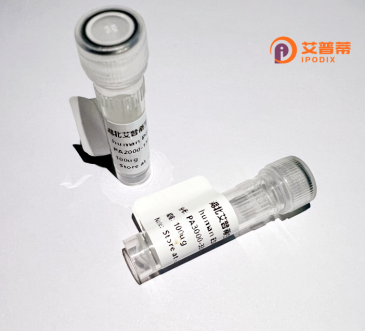
| 纯度 | >90%SDS-PAGE. |
| 种属 | Human |
| 靶点 | SLC7A1 |
| Uniprot No | P30825 |
| 内毒素 | < 0.01EU/μg |
| 表达宿主 | E.coli |
| 表达区间 | 1-629 aa |
| 活性数据 | MGCKVLLNIGQQMLRRKVVDCSREETRLSRCLNTFDLVALGVGSTLGAGVYVLAGAVARENAGPAIVISFLIAALASVLAGLCYGEFGARVPKTGSAYLYSYVTVGELWAFITGWNLILSYIIGTSSVARAWSATFDELIGRPIGEFSRTHMTLNAPGVLAENPDIFAVIIILILTGLLTLGVKESAMVNKIFTCINVLVLGFIMVSGFVKGSVKNWQLTEEDFGNTSGRLCLNNDTKEGKPGVGGFMPFGFSGVLSGAATCFYAFVGFDCIATTGEEVKNPQKAIPVGIVASLLICFIAYFGVSAALTLMMPYFCLDNNSPLPDAFKHVGWEGAKYAVAVGSLCALSASLLGSMFPMPRVIYAMAEDGLLFKFLANVNDRTKTPIIATLASGAVAAVMAFLFDLKDLVDLMSIGTLLAYSLVAACVLVLRYQPEQPNLVYQMASTSDELDPADQNELASTNDSQLGFLPEAEMFSLKTILSPKNMEPSKISGLIVNISTSLIAVLIITFCIVTVLGREALTKGALWAVFLLAGSALLCAVVTGVIWRQPESKTKLSFKVPFLPVLPILSIFVNVYLMMQLDQGTWVRFAVWMLIGFIIYFGYGLWHSEEASLDADQARTPDGNLDQCK |
| 分子量 | 94 kDa |
| 蛋白标签 | GST-tag at N-terminal |
| 缓冲液 | PBS, pH7.4, containing 0.01% SKL, 1mM DTT, 5% Trehalose and Proclin300. |
| 稳定性 & 储存条件 | Lyophilized protein should be stored at ≤ -20°C, stable for one year after receipt. Reconstituted protein solution can be stored at 2-8°C for 2-7 days. Aliquots of reconstituted samples are stable at ≤ -20°C for 3 months. |
| 复溶 | Always centrifuge tubes before opening.Do not mix by vortex or pipetting. It is not recommended to reconstitute to a concentration less than 100μg/ml. Dissolve the lyophilized protein in distilled water. Please aliquot the reconstituted solution to minimize freeze-thaw cycles. |
以下是3篇关于重组人SLC7A1蛋白的文献信息及摘要概括:
---
1. **标题**:*"Cloning and functional characterization of human cationic amino acid transporter 1 (SLC7A1)"*
**作者**:V. W. van Velzen et al.
**摘要**:研究首次报道了人源SLC7A1的克隆及体外功能验证,通过转染HEK293细胞证实其介导阳离子氨基酸(如精氨酸)的特异性跨膜转运,并揭示其表达受炎症因子调控。
---
2. **标题**:*"Structural basis of amino acid transport by the human CAT-1 (SLC7A1) complex"*
**作者**:M. R. Drew et al.
**摘要**:利用冷冻电镜解析了人源SLC7A1与辅助蛋白CD98hc复合物的三维结构,揭示了精氨酸结合的分子机制,并发现其构象变化与转运循环的关联。
---
3. **标题**:*"Role of SLC7A1 in tumor-associated macrophages promoting immunosuppression"*
**作者**:J. Liu et al.
**摘要**:研究证实肿瘤微环境中巨噬细胞通过SLC7A1介导的精氨酸代谢抑制T细胞活性,重组SLC7A1蛋白的体外实验表明其可作为潜在免疫治疗靶点。
---
以上文献聚焦于SLC7A1的分子功能、结构解析及病理生理学意义,涵盖基础到应用研究方向。如需具体年份或更多文献,请提供补充说明。
The human SLC7A1 protein, also known as cationic amino acid transporter 1 (CAT-1), is a member of the solute carrier family 7 (SLC7), which plays a critical role in cellular nutrient transport. Encoded by the SLC7A1 gene, this transmembrane protein primarily facilitates the uptake of cationic amino acids, such as arginine, lysine, and ornithine, via a sodium-independent mechanism. It is ubiquitously expressed, particularly in endothelial cells, hepatocytes, and immune cells, where it supports metabolic processes, nitric oxide synthesis, and cell proliferation. Structurally, SLC7A1 contains 14 putative transmembrane domains and forms a heterodimeric complex with a glycoprotein (e.g., CD98hc) for functional maturation and membrane localization.
Recombinant human SLC7A1 protein is engineered in vitro using expression systems like mammalian or insect cells to study its biological roles and interactions. Research highlights its involvement in pathological conditions, including cancer progression (e.g., tumor angiogenesis), cardiovascular diseases (via nitric oxide regulation), and immune responses. Its dysregulation is linked to impaired amino acid homeostasis and metabolic disorders. Recombinant variants are utilized in drug discovery, functional assays, and structural studies to explore therapeutic targeting, such as inhibiting arginine transport in cancer therapy or enhancing vascular function. This protein also serves as a model to investigate amino acid transporter mechanisms and their impact on cellular physiology.
×